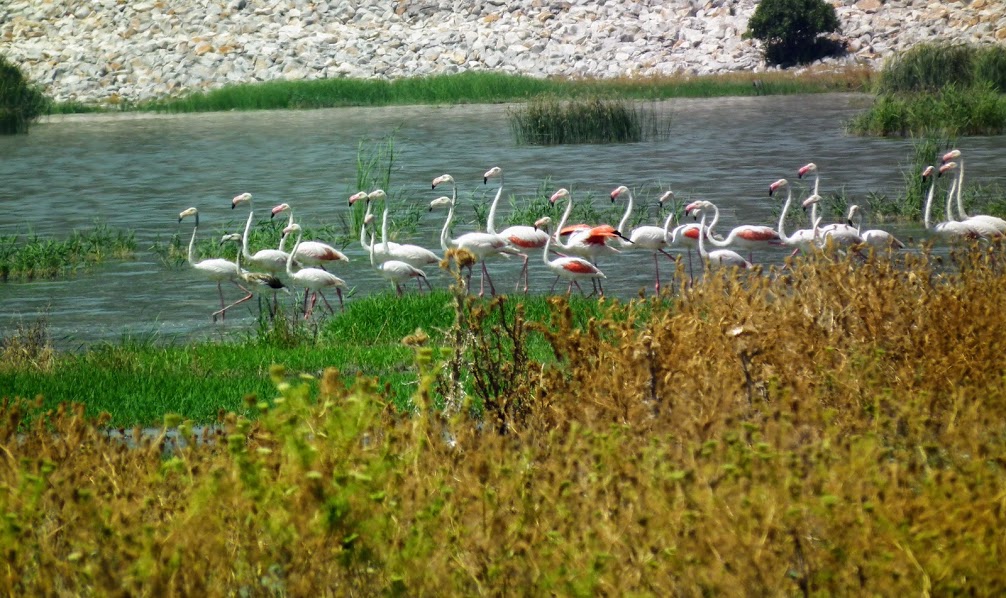
There should be thousands of birds at this time of the year, Dimitris Michalakis from the Karla Lake management authority told me. In early August this year, I saw 77 species here (69 on the lake, plus 8 more in the surrounding areas) but barely more than a thousand individuals.
Located in Thessaly province in central Greece, what is now left of the lake where the god Apollo was married and where the Argonauts built their kingdom is officially called the reservoirs of the former Lake Karla. Have you ever been at a former lake? Now I can say I was.
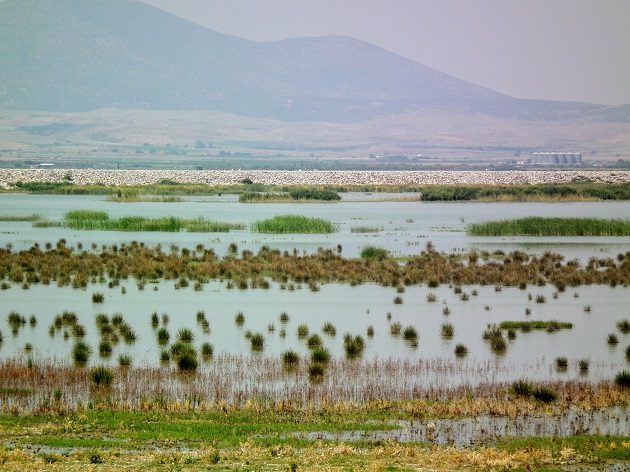
Before it was drained for agriculture in 1962, Lake Karla covered 180 km2 / 70 mi2 – a good portion of the eastern Thessaly Plain and was among the largest wetlands of Europe (visit the Management Body of the lake’s GIS platform). With EU funds, the restoration started in 2009 when embankments were built to create one large and six more small reservoirs.
I find it hard to call it a reservoir, so I will continue to call it a lake. Reaching the northernmost corner of the (largest) lake, I turned west in order to explore it counter-clockwise, so the lake would remain on my driver’s side.
The embankments are high and bare, edged by a canal with a few herons and egrets and surrounded by almost bare soil, baked in this summer’s heat wave (when I was a kid, heat waves used to last for days, up to a week, but this one has lasted almost a month already and is not weakening). I pass the first of several dead cows. This one was already dried up, only skin and bones, but I did not see traces of any scavengers around.
I drove mostly along the dirt track below the embankment, climbing it here and there to scan the lake. In the northern section, the water was deep, interspersed by reed-islets, but the only birds were a few Little Egrets and Black-headed Gulls.
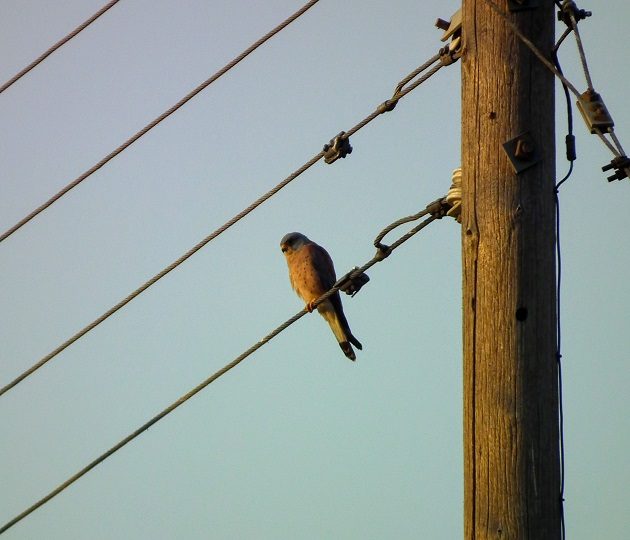 Lesser Kestrel
Lesser Kestrel
There was a Short-toed Eagle ahead, taking flight to be replaced by another ST Eagle. These two were only the first of several I saw. In a shallow pond, there were three young Common Shelducks. At first I dismissed them for some hybrid geese, until I recognized their JIZZ. In my homeland, some 800 km / 500 mi further north, these ducks are common on migration but very rare in the breeding season and I realized that these are my first young birds – ever. A few Lesser Kestrels by the dyke wall, then a Black-eared Wheatear at some cattle fencing. Common Kestrels could be seen, too, but were outnumbered by their more gregarious threatened cousins.
The commonest shrike of the area is the locally ubiquitous Lesser Grey Shrike, followed by the Woodchat Shrike, while the frequent Red-backed Shrike is lagging behind.
Two more dead cows later, I reached the southernmost corner of the lake with its mudbars, reedbeds and a few artificial rocky islets. The birds appeared plentiful here and I climbed the dyke to scan the shallows. Several Glossy Ibises, two dozen Gull-billed Terns and Collared Pratincoles, a few Dalmatian Pelicans, Black Terns, Dunlins…
Further along the dyke, a pick-up stopped and a young man in deep angling overall-boots started wading through the lake, flushing the birds! ‘Hey! I am trying to count them all! What do you think you are doing?’
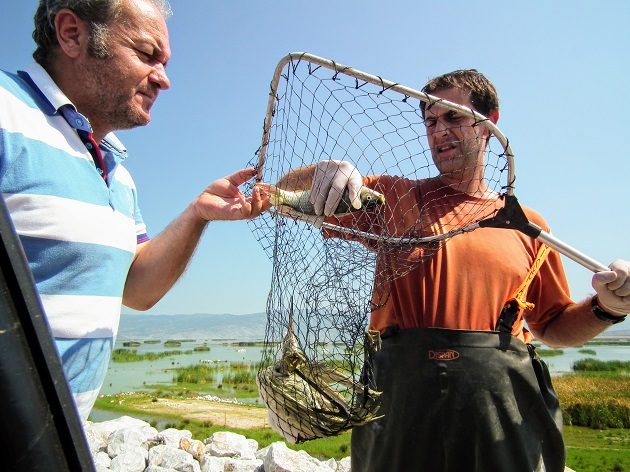
I drove to their car to find Dimitris Michalakis of the Management Body of the Eco-development Area of Karla-Mavrovouni-Kefalovrisi-Velestino, who explained that Ioannis Vergos was doing that on purpose, to see how quickly they reacted to disturbance, what their condition was and to collect samples of dead or dying birds and fishes. The birds are dying, he told me and continued, we found dead Grey Heron, Little Egret and a threatened Dalmatian Pelican today. This year, we had about 65 dead pelicans.
What is killing them? We hope to find out after post mortem analysis of these samples. Botulism? We do not know, says Dimitris.
Several Stone Curlews flew in front of us, followed by one Long-legged Buzzard. Yannis came back with a dead Little Egret in his net. Hopefully, this bird will tell us its story.
I left them to their work and continued counting the southern shore. Some 66 Eurasian Spoonbills, White Stork, Western Marsh Harrier, two Black Storks, seven Greater Flamingoes, more ibises and pelicans…
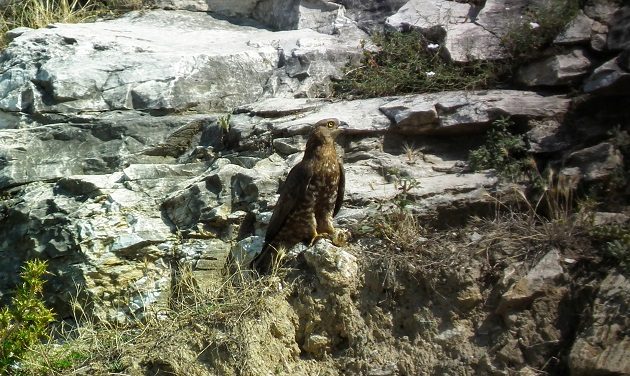 European Honey Buzzard
European Honey Buzzard
At the SE corner, one Eastern Olivaceous Warbler stopped me, almost calling me to a smaller dirt track under a high embankment resembling a dam wall. There is a canal next to the track and a dry, thorny pasture spreading wide. Lesser Grey and Woodchat Shrikes, Northern and Black-eared Wheatears, more ibises and Stone Curlews, Crested Lark, one young and very cooperative Honey Buzzard, a specialist feeding on larvae out of a nest of wasps a mere dozen metres in front of me, and two large eagles in a thermal… Lesser Spotted Eagles!
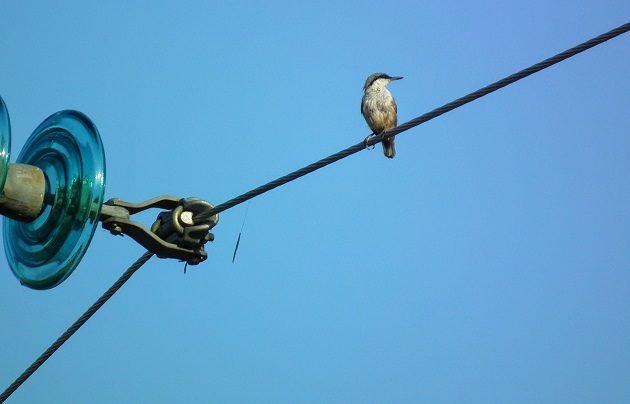 Western Rock Nuthatch
Western Rock Nuthatch
Now the heat was on, my car showing 35oC / 95oF outside and not much less inside. I head north along the eastern shore. Cirl Bunting on a wire, then a very noisy bird… looking for it… on a wire, too, a Western Rock Nuthatch! The other two joined the first one, to chase each other through the rocky maquis.
At the Pirgos Point further north, opposite to an artificial pelican breeding island (with no visible traces of nesting), there were shallows with 22 more spoonbills and 25 more flamingoes, along with two dozen Eurasian Teals and some 30 shorebirds that were flushed by a Marsh Harrier, but I couldn’t observe them in water without disturbing the flamingoes, so they remained unidentified (generally, the most numerous shorebird species on the lake was the Dunlin).
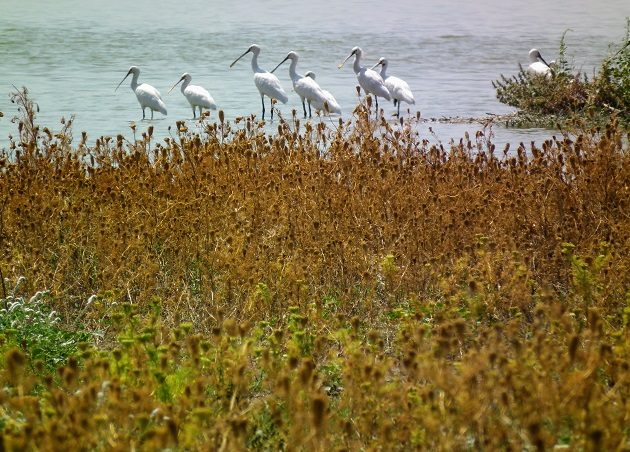 Eurasian Spoonbills
Eurasian Spoonbills
Soon the lake ends. Immediately north of it I found another Short-toed Eagle and a very cooperative close-range Long-legged Buzzard.
Karla Lake is indeed a very recommendable birding area. I also birded the Thessaly Plain north of the main reservoir (quite a few Lesser Kestrels) and the low Mavrovouni mountain east of it (not much, Cirl Buntings were the best birds.)
Yet, what is killing the birds of Lake Karla? At the time of writing, we still do not know.
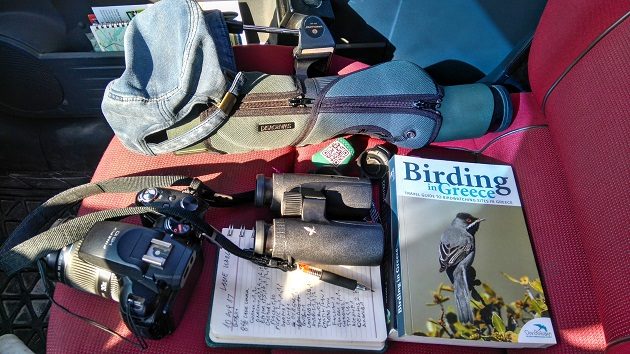
Practicalities
Best seasons
Spring (migrants and breeding species) and winter (wintering waterbirds).
Getting there
The Karla Lake lies 30 km north of the port of Volos, some 10 km east of the main Thessaloniki – Athens highway.
Sections of the lake
The largest reservoir of the former Karla Lake can be divided into four sides: western embankment, eastern embankment (with a more natural section of shallows by the Pirgos Point), southern shore (natural shore, without the dyke) and a small section of southeastern embankment (where the Lesser Spotted Eagles were).
I visited the lake in summer only, so may be a bit biased, but my recommendation is, avoid the embankments: they are too steep, too deep and mostly of no interest to birds (all but the southernmost section of the western dyke which overlooks the southern corner of the lake). The western section turned out to be the least productive, although it may attract diving birds in winter months.
Waterbird-wise, the most productive areas were the southernmost corner, followed by the southern shore and the natural eastern shore by the Pirgos point in the northern section of the eastern embankment. Dry, semi-desert like habitats are to be found in the field below the SE dyke and that section offered some great sights.
Mount Mavrovouni to the east of the lake is at its most productive in spring (migration and breeding), but in August wasn’t worth a visit. Finally, in the eastern Thessaly Plain surrounding the lake some great birds can be found and it is worth devoting some time to those fields, especially near some puddle or a pond.
Where to stay
The Pelion Peninsula (of which I wrote here) south of Volos offers some nice beaches and less crowded villages.
My Karla Lake and surroundings August bird list (the highest figure of my two visits, on 10 and 12 August, are mentioned):
Mute Swan – Cygnus olor 18
Common Shelduck – Tadorna tadorna 5
Mallard – Anas platyrhynchos 86
Eurasian Teal – Anas crecca 20
Ferruginous Duck – Aythya nyroca 2
Little Grebe – Tachybaptus ruficollis 4
Great Crested Grebe – Podiceps cristatus 5
Black-necked Grebe – Podiceps nigricollis 1
Greater Flamingo – Phoenicopterus roseus 32
Black Stork – Ciconia nigra 3
White Stork – Ciconia ciconia 5
Pygmy Cormorant – Microcarbo pygmeus 1
Great Cormorant – Phalacrocorax carbo 35
Great White Pelican – Pelecanus onocrotalus 1
Dalmatian Pelican – Pelecanus crispus 5
Grey Heron – Ardea cinerea 90
Purple Heron – Ardea purpurea 2
Great White Egret – Ardea alba 17
Little Egret – Egretta garzetta 132
Squacco Heron – Ardeola ralloides 12
Black-crowned Night-Heron – Nycticorax nycticorax 1
Glossy Ibis – Plegadis falcinellus 36
Eurasian Spoonbill – Platalea leucorodia 112
European Honey-buzzard – Pernis apivorus 1
Short-toed Eagle – Circaetus gallicus 5
Lesser Spotted Eagle – Clanga pomarina 2
Western Marsh Harrier – Circus aeruginosus 4
Common Buzzard – Buteo buteo 6
Long-legged Buzzard – Buteo rufinus 2
Eurasian Coot – Fulica atra 170
Stone-curlew – Burhinus oedicnemus 5
Black-winged Stilt – Himantopus himantopus 7
Little Ringed Plover – Charadrius dubius 9
Dunlin – Calidris alpina 24
Common Sandpiper – Actitis hypoleucos 2
Green Sandpiper – Tringa ochropus 4
Spotted Redshank – Tringa erythropus 1
Wood Sandpiper – Tringa glareola 2
Collared Pratincole – Glareola pratincola 30
Black-headed Gull – Chroicocephalus ridibundus 81
Yellow-legged Gull – Larus michahellis 133
Gull-billed Tern – Gelochelidon nilotica 14
Black Tern – Chlidonias niger 15
Common Tern – Sterna hirundo 6
European Turtle Dove – Streptopelia turtur 11
Collared Dove – Streptopelia decaocto 38
Common Swift – Apus apus 1
Common/Pallid Swift – Apus apus/pallidus 20
Eurasian Hoopoe – Upupa epops 1
European Bee-eater – Merops apiaster 10
Lesser Kestrel – Falco naumanni 19
Common Kestrel – Falco tinnunculus 2
Red-backed Shrike – Lanius collurio 8
Lesser Grey Shrike – Lanius minor 12
Woodchat Shrike – Lanius senator 7
Eurasian Jay – Garrulus glandarius 2
Eurasian Magpie – Pica pica 12
Eurasian Jackdaw – Corvus monedula 10
Hooded Crow – Corvus cornix 30
Common Raven – Corvus corax 5
Crested Lark – Galerida cristata 4
Barn Swallow – Hirundo rustica 49
Red-rumped Swallow – Cecropis daurica 7
Eurasian Blue Tit – Cyanistes caeruleus 2
Great Tit – Parus major 7
Western Rock Nuthatch – Sitta neumayer 3
Eastern Olivaceous Warbler – Iduna pallida 1
Northern Wheatear – Oenanthe oenanthe 2
Black-eared Wheatear – Oenanthe hispanica 8
Eurasian Blackbird – Turdus merula 3
European Starling – Sturnus vulgaris 50
Western Yellow Wagtail – Motacilla flava 5
Cirl Bunting – Emberiza cirlus 5
European Greenfinch – Chloris chloris 2
European Goldfinch – Carduelis carduelis 3
House Sparrow – Passer domesticus 103
Eurasian Tree Sparrow – Passer montanus 3
Update: The small amount of water and its poor quality combined with high temperatures were lethal for the birds, creating favourable conditions for the toxic cyanobacteria.













Very helpful for prerering our travel to Thessaly.
Thanks
Thanks for letting me know. It actually feels great. (Especially when one is considering starting a bird company…)
Regular visitors to Pelion and will finally get to visit Lane Karla during first week in September. Very useful information Dragan. Several “target species “ for me. Didn’t realise Great white Pelican are recorded here. Would you like my visit report?
Best regards.
Until recently, one of the largest Dalmatian Pelican colony was here too, 3rd or 4th in Greece, but after the bird fly, I do not know what to expect next. Still, the epidemic was not so bad in lowland areas, as it was in the mountains (Lake Prespa).
And yes, please do leave a comment after your visit.
Since 2016, Lake Karla was the 2nd largest colony of Dalmatian Pelicans in Greece. Yet, the small amount of water & its poor quality + high temperatures were lethal for the birds, creating favourable conditions for the toxic cyanobacteria.